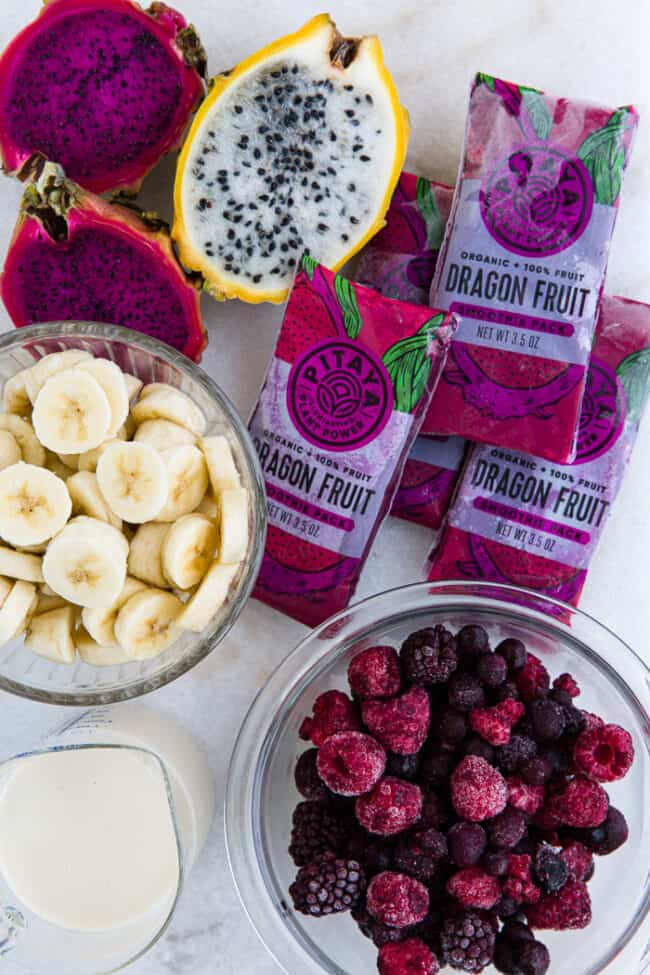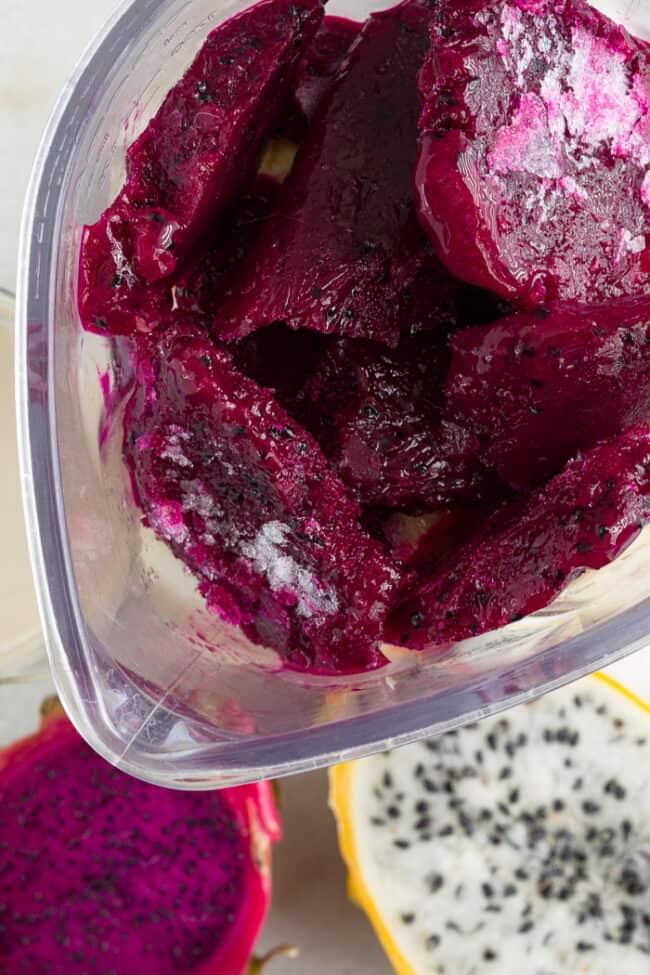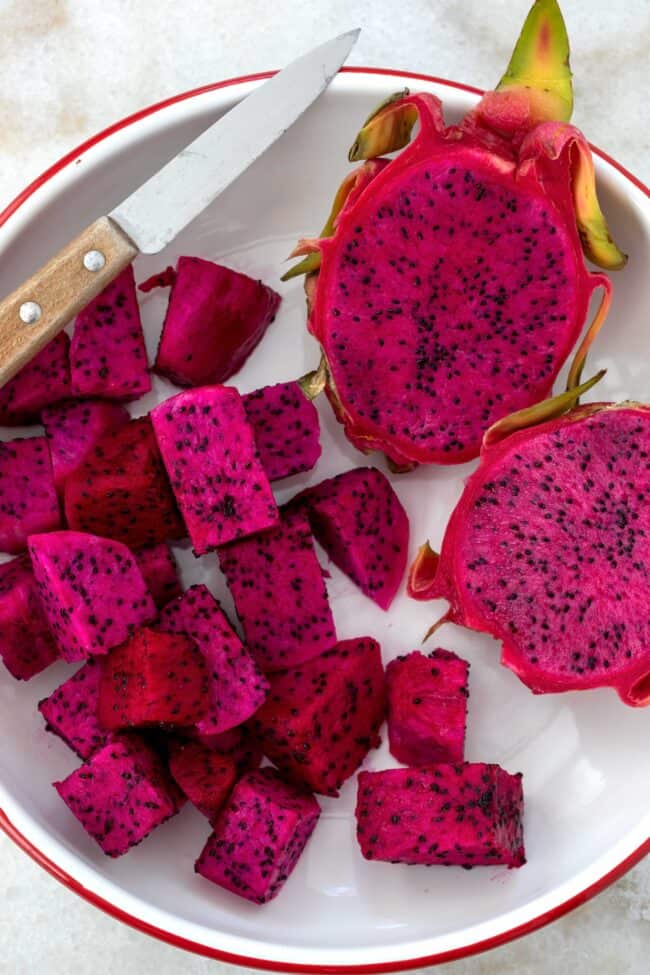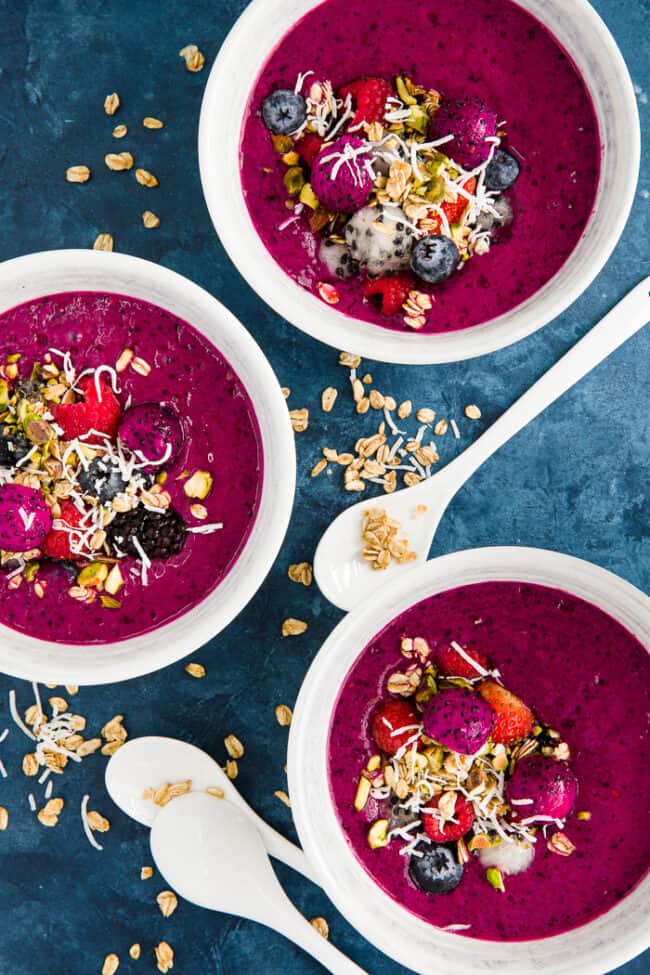Pitaya Bowl
Learn how to make a pitaya fruit bowl (also called pitahaya, pithaya and dragon fruit smoothie bowl) with this easy recipe. This Pitaya Bowl recipe is made with red dragon fruit, frozen bananas and berries, and oat milk. Pitaya bowls make a light vegan breakfast, afternoon snack, post workout nourishment, and a healthy chilled dessert.
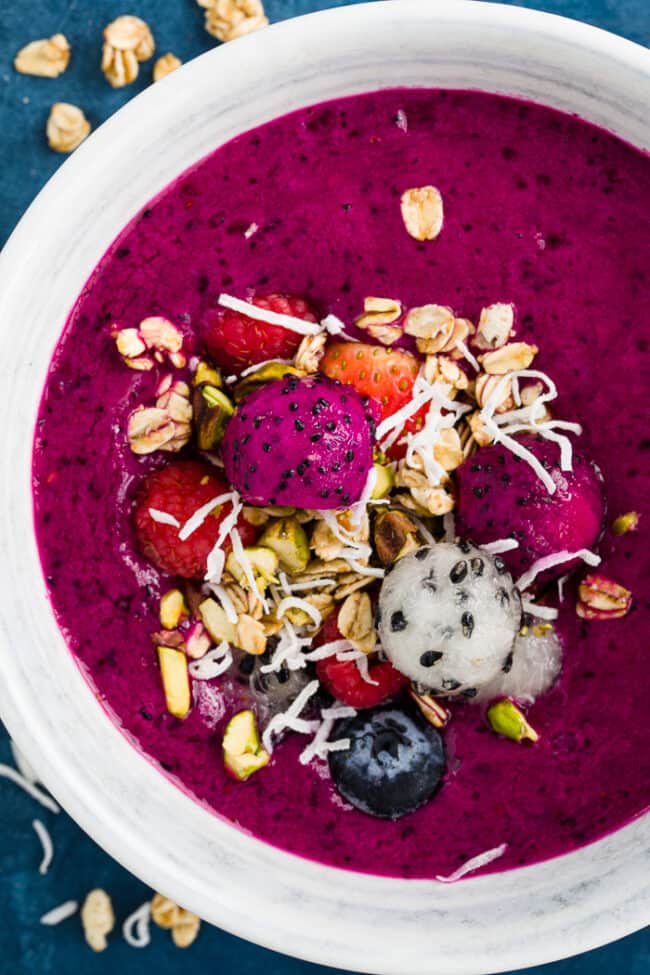
Dragon fruit smoothie bowl is a quick and easy family-friendly recipe to make. They’re not only delicious and popular, but they’re loaded with immune-boosting ingredients!!
What’s a Pitaya Bowl?
This dragon fruit smoothie bowl is similar to my acai bowl. Pitaya bowls are made up of a thick luscious blend of frozen pitaya, frozen bananas, fruit (fresh or frozen) and vegan milk (nut milk, coconut milk, oat milk, etc) or fruit juice. The consistency is thicker than a smoothie, it’s served in a bowl, eaten with a spoon, and the best part is it’s garnished with fresh seasonal fruit, nuts, seeds, granola, shredded coconut, whatever you like. Pitaya bowls are typically served for breakfast, but they make a great afternoon snack and they’re decadent enough to serve for dessert.
Pitaya Bowl Recipe
- Frozen Dragon Fruit (frozen pitaya packet). These can be found at the health food and some grocery stores. Pitaya (dragon fruit).
- Frozen Bananas. Frozen bananas give smoothies and smoothie bowls such a creamy and almost dessert-like texture, more so than regular bananas sitting in your fruit bowl will.
- Frozen mixed berries. I like to use frozen fruit when making the base, and then garnish the Pitaya bowl with fresh fruit.
- Non-dairy milk. I prefer to use oat milk, but any nut milk or unsweetened fruit juice will work. Or just splash in a little water if you don’t want the added calories.
- Almond Butter. This is optional – sometimes I like to add a heaping tablespoon of nut butter to the mix for the added protein.
Find printable recipe with the measurements below.
How to Make Pitaya Bowl
Pitaya bowls come together in a pinch just like making a smoothie. If you want to add more protein to your pitaya bowl, add a tablespoon or two of almond butter (or any other nut butter you like) or sprinkle in some chia seeds or flax seeds.
- Thaw dragon fruit. Run warm water over the packages to thaw them a bit. It will make it easier for the machine to break the pieces up.
- Blend ingredients. Add your vegan milk (or juice) first, then toss in the sliced frozen bananas, frozen berries, frozen dragon fruit and blend to a thick consistency. If it’s too thick, then add a little more liquid.
- Garnish Pitahaya bowl. Scoop the thick mixture into a bowl and garnish with fruit, nuts, seeds and granola. Whatever you like.
Pitaya Bowl Toppings
Here’s some of my favorite smoothie bowl toppings.
- Fresh berries (strawberries, raspberries, blueberries and blackberries)
- Slices of fruit (banana, peaches, mango, papaya)
- Nuts (almonds, walnuts, cashews)
- Seeds (help, chia, flax)
- Granola
- Shredded coconut
What is Dragon Fruit?
Dragon fruit is a beautiful exotic fruit known for its vibrant red skin and sweet tasting flesh. The texture of the inside of dragon fruit might remind you of a kiwi with its soft and edible seeds. Dragon fruit is a cousin of the cactus pear. If you love dragon fruit, be sure to check out my Mango Dragonfruit Refresher.
What Does Dragon Fruit Taste Like?
Dragon fruit has a mild and slightly sweet flavor similar to kiwi, but without the tartness.
Where Does Dragon Fruit Grow?
The dragon fruit is native to Central America but its grown commercially in Israel and Vietnam and imported to the United States. Red dragon fruit has a bright magenta colored flesh. The flavor is a tad sweeter than the dragon fruit with white flesh. Red dragon fruit is abundantly grown in Nicaragua and commercially grown in Israel. Dragon fruit with yellow skin and white flesh is abundantly grown in Ecuador, and it’s slightly more sweet than red dragon fruit.
Pitaya, Pitahaya or Dragon Fruit?
This fruit has a few names (and spellings) that it goes by – pitaya, pitahaya, pithaya and dragon fruit. The commercial growers in Israel refer to the fruit as pitaya or pitahaya and the commercial growers in Vietnam call the fruit “thang loy” which apparently translates to “dragon fruit”.
Looking for more smoothie recipes to make?
- Chocolate Cherry Oat Smoothie
- Banana Milk
- Blueberry Spinach Smoothie
- Strawberry Oatmeal Smoothie
- Strawberry Cacao Smoothie
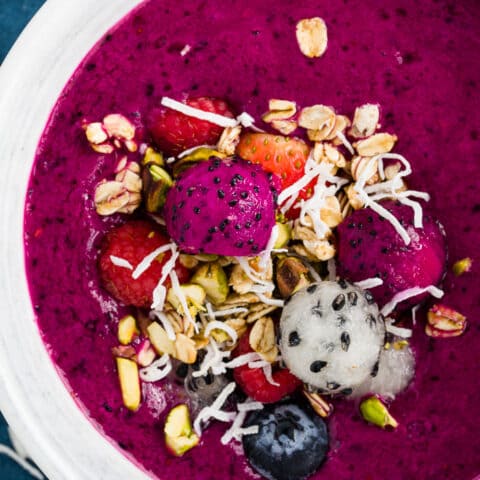
Pitaya Bowl
Learn how to make a pitaya fruit bowl (also called pitahaya, pithaya and dragon fruit smoothie bowl) with this easy recipe. This Pitaya Bowl recipe is made with red dragon fruit, frozen bananas and berries, and oat milk. Pitaya bowls make a light vegan breakfast, afternoon snack, post workout nourishment, and a healthy chilled dessert.
Ingredients
- 1 3.5 ounce frozen pitaya packet (or 1 cup frozen or fresh red dragon fruit)
- 1/2 cup frozen bananas
- 1/2 cup frozen mixed berries
- 1/3 cup oat milk (or nut milk or water)
Instructions
- Thaw dragon fruit. Run warm water over the packages to thaw them a bit. It will make it easier for the machine to break the pieces up.
- Add your vegan milk (or juice) first, then toss in the sliced frozen bananas, frozen berries, frozen dragon fruit and blend to a thick consistency. If it's too thick, then add a little more liquid.
- Scoop the thick smoothie mixture into a bowl and garnish with as much fruit, nuts, seeds, granola and shredded coconut as you like.
Notes
Pitaya Bowl Toppings
- Fresh berries (strawberries, raspberries, blueberries and blackberries)
- Slices of fruit (banana, peaches, mango, papaya)
- Nuts (almonds, walnuts, cashews)
- Seeds (help, chia, flax)
- Granola
- Shredded coconut
Nutrition Information:
Yield:
1Serving Size:
1Amount Per Serving: Calories: 237Total Fat: 2gSaturated Fat: 0gTrans Fat: 0gUnsaturated Fat: 1gCholesterol: 0mgSodium: 9mgCarbohydrates: 57gFiber: 10gSugar: 34gProtein: 4g
theharvestkitchen.com attempts to provide accurate information, however, this nutritional information is provided as a courtesy and is an estimate only. The nutritional information provided comes from online sources and calculations.
